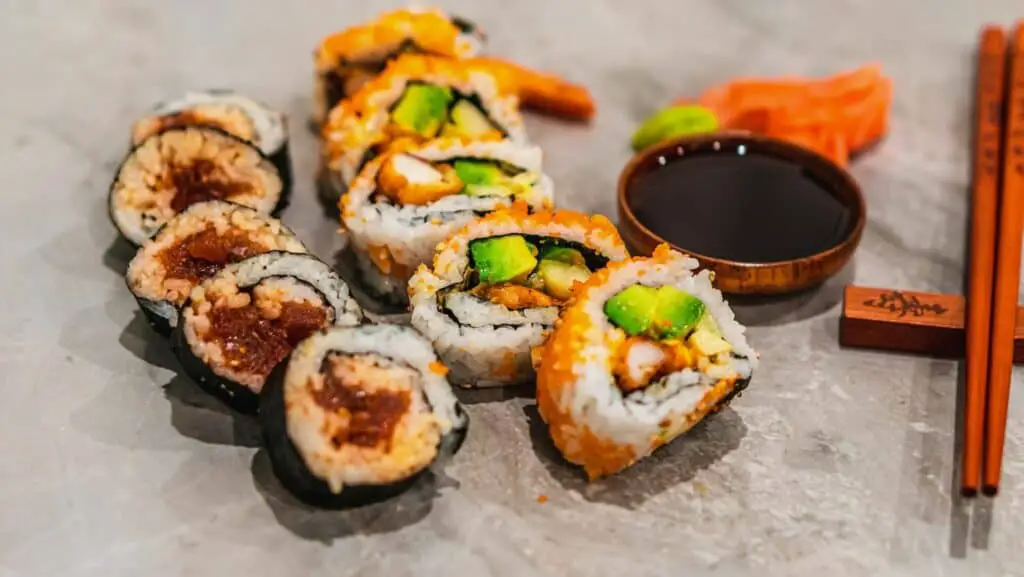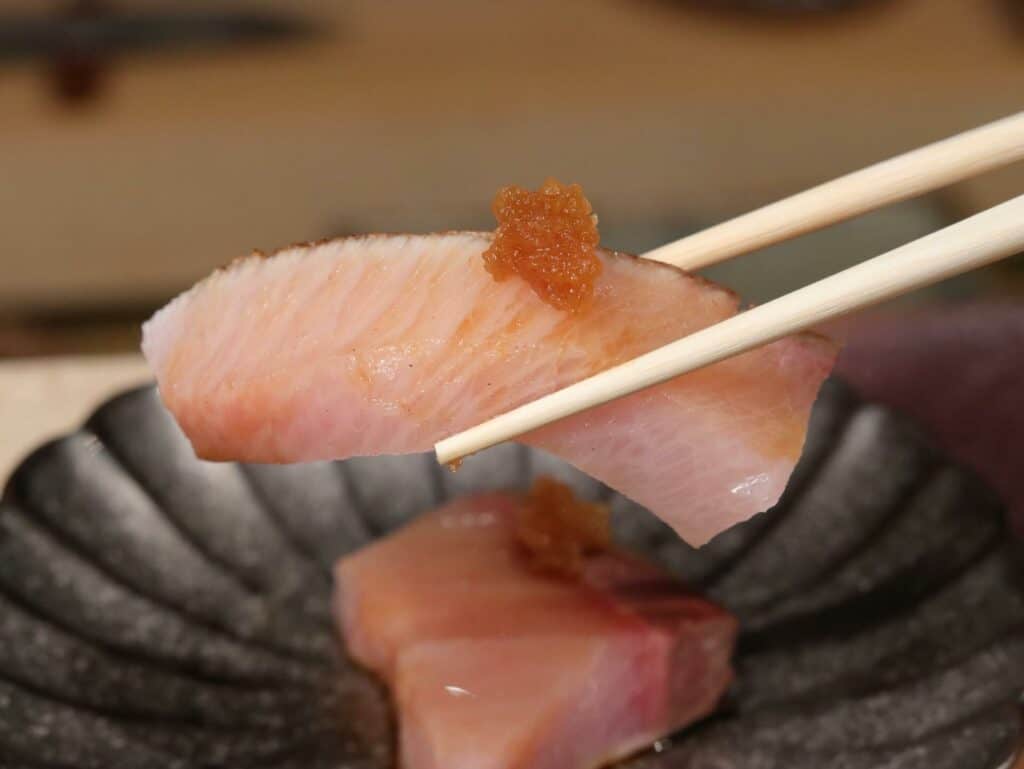New Yorkers love their raw seafood bites as much as most Americans do, and Sushi Sushi is a place that offers comfort to this craving. However, if you don’t eat raw fish, you’re probably wondering is Sushi Sushi vegan.
Is Sushi Sushi vegan? No, this restaurant is not vegan. It makes seafood dishes out of the freshest, high-quality, and hand-selected fish. The ingredients used include Japanese yellowtail, US striped bass, premium yellowfin tuna, Scottish salmon, Long Island fluke, premium unagi, and many more.


This Japanese cafe is packed with sashimi and makizushi for anyone looking for Asian delicacies, but also offers rice bowls and bento. But even if you’re not a resident of the metropolis, and you’re simply passing through NYC, you should give this restaurant a visit and enjoy the tasty bites.
Is Sushi Sushi Vegan?
The Japanese cafe emerged on New York’s dining scene back in 2013, and since then, it has offered fresh seafood delicacies to everyone that loves them. The restaurant makes traditional fish dishes, such as sushi, sashimi, makizushi, with the addition of bento and rice bowls. However, the cafe isn’t offering a menu for vegans, and it takes pride in preparing meals with premium and high-quality, hand-selected fish.
Some Simple Facts That Prove It’s the Best Cuisine in NYC
Although not for people who do not consume any animal products, the restaurant takes pride in the premium ingredients it uses to make the famous Japanese dish. Tuna is a tasty component to a delicious bite, and the cafe’s red meat of yellowfin tuna is often the first choice of many customers. The cafe serves makizushi and other forms of raw food delicacies with salmon, too, that is imported from farms on the Faroe Islands. This is also a popular choice by foodies because of its rich texture and subtle thickness. The buttery, creamy, and rich flavor of yellowtail, coming from the northwest Pacific, is a true standard in Japan’s gourmet cuisine.
A Guide to Fancy Sushi and Sashimi
While sushi is the pairing of vinegared rice and raw fish, which can then be made as nigiri or maki, sashimi is different. Roughly translated, it means “pierced body,” and it’s a delicacy made from thinly sliced premium-grade fish. The fish is caught on a single line and frozen on the spot to avoid building up the lactic acid. It is usually eaten plain, with an addition of soy sauce, and is one of the delicacies served in this NYC’s Japanese-type cafe.

Curious to know more about other Japanese delicacies? Read also :
Are Buckwheat Noodles Soba Noodles?
Shrimp Rolls vs Shrimp Tempura
Best Oil For tempura
Best Shrimp For Tempura
Is tempura Gluten Free?
What Ramen Does Naruto Eat?
A Simple Recipe for Home Made Vegetarian Makizushi
The famous delicacy is loved by many, but the fact it consists of thin slices of raw fish is usually an obstacle for vegetarians. However, tofu is a great substitute that can be used for making delicious makizushi, and here’s a simple list of ingredients that will make your rolls really tasty:
- These rolls are made with extra firm pressed tofu that you should cut into thin strips. The next step is to stir-fry them to get a nice crispy feeling. Uncooked tofu is also an available option for an extremely quick and easy meal.
- The next ingredient is tempeh (fermented soybeans) or any other plant-based proteins.
- Cucumber and a carrot, sliced in very thin strips (this is where a good chef’s knife comes in handy). Avocado is also a must, so cut it in thin slices that can be easily rolled.
- Rice, although some people use quinoa and cauliflower substitutes as well.
- Nori seaweed sheets, which can be found in most grocery stores.
- Optionally, you can use cream cheese as a vegetarian option, but there are also many different brands of tasty store-bought vegan cream cheeses.
When you prepare all these ingredients, don’t forget you’ll need a mat for rolling the makizushi. Cook the rice (which is a perfect ingredient for gluten-intolerant, as it is gluten-free) and place it in a bowl until it cools down. Cook vinegar, sugar, and salt in a pot, and mix it with the rice. Spread nori on the mat, and add the rice evenly. The final step before you roll the makizushi is to add all the other ingredients.
Wondering if sushi is Chinese food?Find out here!
What Kind of Rolls Can Vegans Eat?
Vegans who are not able to discover Asian-styled vegan restaurants in their proximity have a variety of ideas available on how to make homemade makizushi. From pickled vegetables to fresh ones, it is only important to have available nori seaweed, a mat, and properly prepared rice. You can freely experiment with various vegetables and tofu to get the perfect taste in a matter of minutes.
The Vegan Makizushi Ideas
Those of you who do not consume animal products aren’t banned from enjoying something similar to makizushi or other types of Asian dishes. If suitable restaurants are not an option, you can make your own makizushi using vegetables that will sit together perfectly.
| Types of vegetable delicacies | What’s it made with |
| Nigiri style | It can be made with shiitake, which gives the rolls a savory and strong taste. Eggplant (either pickled or grilled) is used to make nasu nigiri, and avocado or butter of the forest is used for avocado nigiri. |
| Makizushi | You can also make and consume kappa maki because it’s made with cucumber. Shinko (pickles) and takuan (pickled radish) are often very loved components among the makizushi fans because they give a tangy taste and crunchy texture. |
| Temaki | While temaki is a term for all makizushi rolled with hands, the most popular vegan choice is the natto temaki made with fermented soybeans. |
| Gunkanmaki | Gunkan-maki or the battleship roll is made out of seaweed salad, dressed with mirin, sesame seeds and oil, red chili, and soy sauce. It’s then piled up on top of rice and wrapped with a strip of nori seaweed. |
| Inarizushi | Made out of sweet tofu skin pouch which is fried, this type of roll is filled with rice and sprinkled with sesame seeds. It’s often offered to the gods in Shinto shrines in Japan. |
While This NYC’s Restaurant Is Not for Vegans, It Welcomes All Lovers of Japanese Cuisine
The restaurant has been a favorite spot for all those who like Spicy Delight Roll (probably the most popular dish in the cafe,) Shrimp Tempura Roll and all the other raw food delicacies on their menu. It does not, however, offer variants of the dish for vegans. But if you’re on the lookout for all the popular dishes of Japanese cuisine, this cafe is the right pick for you.